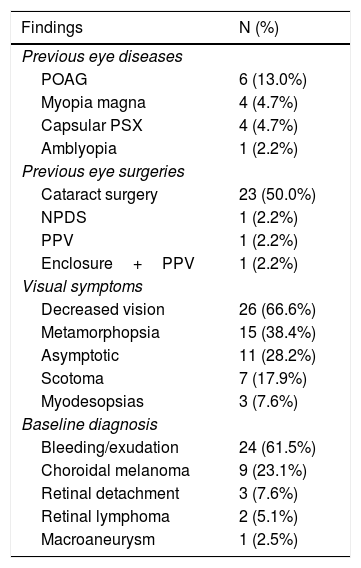To publish the clinical characteristics of peripheral exudative hemorrhagic chorioretinopathy (PHEC) in the Spanish population.
MethodsRetrospective study and analysis of results in patients diagnosed with PHEC. The clinical characteristics, by OCT, the treatment used and the evolution after treatment were collected.
Results39 eyes of 23 patients with PHEC were evaluated. The average age at diagnosis was 79 years (66–94 years). The main ocular symptom was low vision in 26 eyes (66.6%); only 11 eyes (28.2%) were asymptomatic. The most frequent referred diagnosis was bleeding/exudation in 24 eyes (61.5%), followed by choroidal melanoma in 9 (23.1%). Intra or subretinal hemorrhages were the type of peripheral lesion most frequently found, in 24 eyes (61.5%). Twenty-five eyes (58.9%) received some type of treatment: 15 eyes (60%) underwent intravitreal injection (IIV) of antiangiogenic agents (anti-VEGF); Laser photocoagulation was performed in 2 cases (8%), Photodynamic therapy in 2 cases (8%) and 6 cases (18.2%) required pars plana vitrectomy (PPV) due to vitreous hemorrhage. There were no changes in visual acuity (VA) in patients followed with observation between baseline 0.66±0.80 (0.04–2.82) and end of follow-up 0.75±0.96 (0.00–2.82) (P=.352), nor for those who received some type of treatment between the beginning 0.78±0.79 (0.04–2.30) and the end 1.22±1.01 (0.04–2.82) (P=.157), possibly due to the large component of atrophic or exudative age-related macular degeneration (AMD) presented in both groups. (29 eyes presented atrophic or exudative AMD)
ConclusionsPHEC is a rare pathology, frequently associated with AMD, which typically presents as a peripheral mass that is frequently confused with choroidal melanoma and other intraocular tumors and hence the importance of learning to identify it, making the correct differential diagnosis and avoid unnecessary treatments. Antiangiogenic therapy is effective in most patients with an active phase (exudative/hemorrhagic) into leading to fibrosis of peripheral hemorrhagic areas.
Publicar las características clínicas de la coriorretinopatía exudativo hemorrágica periférica (CEHP) en la población española.
MétodosEstudio retrospectivo y análisis de resultados en pacientes con diagnóstico de CEHP. Fueron recogidas las características clínicas, por OCT, el tratamiento utilizado y la evolución posterior al tratamiento.
ResultadosSe evaluaron 39 ojos de 23 pacientes con CEHP. La edad promedio al diagnóstico fue de 79 años (66–94 años). El síntoma ocular principal fue la disminución visual en 26 ojos (66,6%), siendo 11 ojos (28.2%) asintomáticos. El diagnóstico de referencia más frecuente fue sangrado/exudación en 24 ojos (61.5%), le siguió melanoma coroideo con 9 (23.1%). Las hemorragias intra o subretinianas fueron el tipo de lesión periférica más frecuentemente encontrado, en 24 ojos (61.5%). Veinticinco ojos (58.9%) recibieron algún tipo de tratamiento: A 15 ojos (60%) se les realizó inyección intravítrea (IIV) de antioangiogénicos (anti-VEGF); se realizó fotocoagulación con láser en 2 casos (8%), Terapia fotodinámica en 2 casos (8%) y 6 casos (18.2%) precisaron vitrectomía vía pars plana (VPP) por hemorragia vítrea. No hubo cambios en la agudeza visual (AV) en los pacientes seguidos con observación entre el inicio 0.66±0,80 (0,04−2,82) y el fin de seguimiento 0,75±0,96 (0,00–2,82) (P=,352), ni para los que recibieron algún tipo de tratamiento entre inicio 0,78±0,79 (0,04–2,30) y fin 1,22±1,01 (0,04–2,82) (P=,157), posiblemente debido al gran componente de degeneración macular asociada con la edad (DMAE) atrófica o exudativa presente en ambos grupos. (29 ojos presentaron DMAE atrófica o exudativa)
ConclusionesLa CEHP es una patología poco frecuente, asociada frecuentemente con DMAE, que se presenta típicamente como una masa periférica que se confunde frecuentemente con melanoma coroideo y otros tumores intraoculares y de ahí la importancia de aprender a identificarla, hacer el correcto diagnóstico diferencial y así evitar tratamientos innecesarios. La terapia antiangiogenica es efectiva en la mayoría de los pacientes en fase activa (exudativa/hemorrágica), llevando a la fibrosis de las zonas hemorrágicas en periferia.













